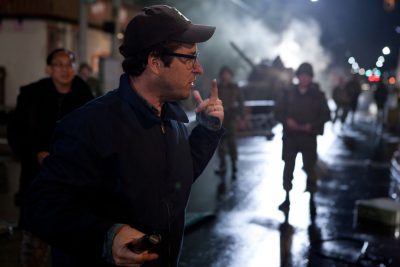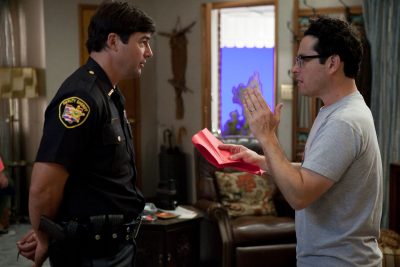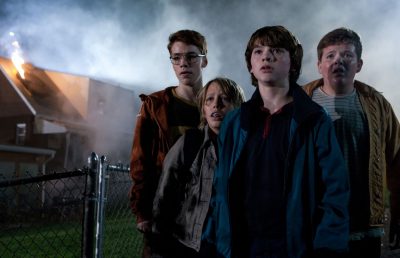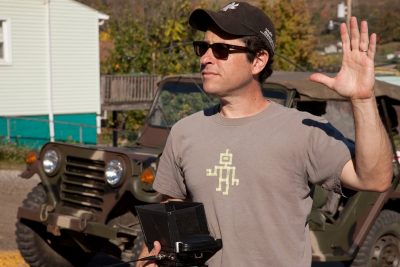For J.J. Abrams’ Super 8, Industrial Light & Magic was tasked with creating the visual effects for the film’s dramatic train crash, the alien creature and its spaceship, and several other key scenes. We talk to senior ILM visual effects supervisor Dennis Muren and animation supervisor Paul Kavanagh about realizing the film’s ‘production value’.
Leading the visual effects effort on the film were ILM VFX supervisors Dennis Muren, Kim Libreri and Russell Earl, along with visual effects producer Chantal Feghali. “It was pretty interesting coming onto the film,” notes Muren, “since I worked on a lot of the movies that this film was trying to remind people of. I really knew the type of feeling that J.J. was going for because I had done similar sorts of shots for Steven. Some of his stuff I think has – I wouldn’t say lost – but it is not popular at the moment. Like holding on shots long enough to feel a reaction from them. Nowadays it’s plot-action-plot-action-plot-action in fast-paced sequences. In those days the shots lasted longer and you had more time to feel it, but you’ve got to keep it interesting for that length of time.”

One of the elements from a previous era of filmmaking that J.J. Abrams revives in Super 8 is the use of anamorphic lenses. ILM of course had to match the anamorphic plates for its visual effects work. “In anamorphic lenses,” says Kavanagh, “you get a lot of barrel distortion – the lens creates a bow effect on the actual image and you get the beautiful lens flares and everything. And especially on a movie that has its roots back in the 70s – that’s something that Spielberg did and J.J. certainly wanted to pay homage to that look of anamorphic lens. We have a process at ILM where we flatten the plate, so that we take the distortion out. We map the lens and have a huge grid set up with lights and when they’re finished shooting we’ll take that lens and shoot on the grid so we know how much distortion is going on at any one point – at all the points of the lens. Then we mathematically correct for that lens to turn it back into a grid so we know what distortion is going on.”
“And we write the serial number down,” continues Kavanagh, “so if we ever use that lens again we can cross-reference against it with the footage we shot of the grid so we don’t have to map it again. Then we do our match-moves and everything to that non-distorted plate, and then we re-distort it with the CG and everything afterwards so it looks correct. It’s quite a process but it’s worthwhile with all the beautiful lens flares and the actual distortion of the lenses. The filmmakers want imperfections in the lens, so we have to look at them and think about them when we’re doing the CG, and we really want to add the imperfections in the CG so that it all sort of ties and has that dirty organic look which filmmakers now really seem to love.”
Super 8’s signature train crash scene, witnessed by a group of budding filmmaking kids making a zombie flick, was planned with the help of ILM animatics and a small model with the train cars to choreograph the action and location of cameras, the running kids and live explosions. J.J. Abrams and DoP Larry Fong filmed the crash sequence at Firestone Ranch, in Agua Dulce, California. Special effects supervisor Steve Riley built a huge train-shaped ram on a green sled that was smashed through the wreckage on set. This was timed with various explosions and extra pieces of debris.

Ultimately, however, most of the crash was realized as computer graphics by ILM and Scanline LA, whose work the ILM team supervised as well, both for the train and explosions. Part of that was because of the sheer size and weight of real train carriages. “They are massive pieces of equipment that are very hard to move around,” notes Kavanagh. “So J.J. built the set of the aftermath, and then we would shoot around it for the actual train crash itself and replace a lot of the aftermath with CG elements. We would paint out the aftermath and replace it as it the tracks were there, then animate the trains going along the track and crashing into each other and digging up the dirt, and placing the kids within it to make it feel like they were in jeopardy.”
One of the most challenging aspects of the crash was actually staging the way in which the carnage occurred in close proximity to the kids. “The train is moving left to right in screen direction – you know – the cowboys go left to right and they come back right to left,” says Kavanagh. “Then the impact compression wave comes back up the train and passes the children right to left. When he was shooting it he had a shot of the kids running down the actual platform and he wanted to see the impact wave of the train go right to left beyond them, so you just felt like they were in this huge jeopardy. Then when they look off to the left they see the destruction coming towards them – so the shockwave has passed them and that was a tough thing to get right.”
To get it ‘right’, ILM and Scanline LA created much of the train crash using rigid dynamics simulations on the carriages. “We would simulate the actual train carriages crashing around and see what we got and see if we got something interesting,” says Kavanagh. “That was in our proprietary software. Then we would take that into Maya and hand-animate on top. And we’d add in some secondary animation done with simulation to help sell the weight of the carriages. Other times we went full simulation to get the impact of the carriages for how one impacted another.”
Fire and explosions seen as the kids try and escape the carnage were mostly digital pyro elements created by Scanline. “Not too long ago you would have to shoot elements and composite them into the shots and it would be a big expensive shoot,” says Kavanagh. “You’d have to shoot the smoke so that it’s going in the right direction and the camera’s at the right speed. Now you can do that CG fire in the computer and that’s how it was done on this movie. There was some pyro shot on set of explosions in the background, but the majority of it was done in the computer.”

To help sell the fire interaction with the actors, lighting cues would be set up for faces, but mostly the scene was shot organically, as Kavanagh explains: “A lot of the time we would just shoot and J.J. would say, ‘Imagine a huge train car is going to come over your head and crash in front of you.’ It’s amazing when you time in the train car coming in over the head and crashing on the cues, it all comes together – they do the little look off to the side and the lighting cue and it really looks believable.”
Interestingly, ILM had to complete a number of train crash shots for the teaser trailer – shots that J.J. Abrams didn’t necessarily want to include in the final film. “He wanted to have it from two perspectives,” recalls Kavanagh. “So when you see the teaser trailer it’s its own little thing. And when you’re in the movie you’ll remember those shots from the teaser trailer but you’ll be seeing the same shot but from a different perspective and that perspective is the kid’s.”
Spoiler alert :

The film’s final scenes, in which the ship forms at the water tower from masses of metal objects and the alien cubes, relied again on ILM previs. “We did previs heavily the end sequence, especially the ship formation,” says Kavanagh. “But we didn’t get into the details exactly of how the ship’s formed from the cubes and the intricate pieces coming to form the ship. We got the shot design down and the feel of it, and the pacing, in the previs, and the events going on in the street, like the camera store bursting out of the window, the toy store with the planes coming through the window.”
At several points in Super 8, one of the kids is determined to film in any way possible that adds ‘production value’, a tongue-in-cheek nod to the filmmaking world. “The irony of that,” jokes Muren, “is that we of course add the production value to JJ’s movie, because J.J.’s got nothing out there except nighttime and we put the train in there and everything. So there’s some sort of double level or six degrees going on there – we became the kid director at that point.”
Images © 2011 Paramount Pictures. All Rights Reserved.
Produced in partnership with The Daily, NY.
For more film news check out The Daily on the Apple iPad from the App Store.
